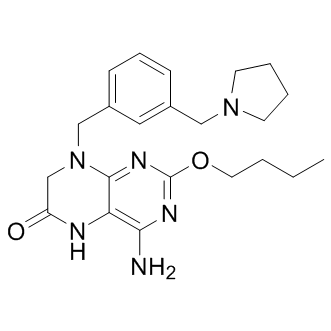| Cas No.: | 1228585-88-3 |
| Chemical Name: | Vesatolimod |
| Synonyms: | GS 9620; GS9620 |
| SMILES: | CCCCOC1=NC2=C(C(=N1)N)NC(=O)CN2CC3=CC(=CC=C3)CN4CCCC4 |
| Formula: | C22H30N6O2 |
| M.Wt: | 410.52 |
| Sotrage: | 2 years -20°C Powder, 2 weeks 4°C in DMSO, 6 months -80°C in DMSO |
| Description: | Vesatolimod (GS-9620) is a potent, selective and orally active agonist of Toll-Like Receptor (TLR7) with an EC50 of 291 nM. |
| In Vivo: | Single oral doses of Vesatolimod (GS-9620) at 0.3 and 1 mg/kg in uninfected chimpanzees demonstrates a dose- and exposure-related induction of serum IFN-α, select cytokines/chemokines, and interferon-stimulated genes (ISG) in the peripheral blood and liver. Following oral administration at 0.3 (n=3), and 1 mg/kg (n=3 and n=4), Vesatolimod (GS-9620) Cmax is 3.6±3.5, 36.8±34.5, and 55.4±81.0 nM, respectively. Peak serum interferon responses occur at 8 h post-dose. The mean peak levels of induced serum IFN-α are 66 and 479 pg/mL at doses of 0.3 and 1 mg/kg, respectively. Vesatolimod (GS-9620) treatment induces ISG transcripts including ISG15, OAS-1, MX1, IP-10 (CXCL10), and I-TAC (CXCL11) in peripheral blood mononuclear cells (PBMC) at 0.3 mg/kg and in both PBMC and the liver at 1 mg/kg[2]. |
| In Vitro: | Vesatolimod (GS-9620) rapidly internalizes into cells and preferentially localizes to and signals from endo-lysosomal compartments. To test this hypothesis, the kinetics of cellular uptake of the compound in Daudi cells using tritiated Vesatolimod (3H-GS-9620) is measured. The kinetics of 3H-GS-9620 accumulation is rapid, reaching concentration-dependent steady-state equilibrium in approximately thirty minutes. Measured intracellular concentration of 3H-Vesatolimod is 5-fold higher than the extracellular concentration of 3H-GS-9620 used to treat cells. Increases in intracellular 3H-Vesatolimod concentrations are roughly proportional with increasing concentrations of 3H-GS-9620[1]. |

 DC Chemicals' products qualify for U.S. tariff exemptions. We guarantee no price increases due to customs duties and maintain stable supply, continuing to deliver reliable research solutions to our American clients.
DC Chemicals' products qualify for U.S. tariff exemptions. We guarantee no price increases due to customs duties and maintain stable supply, continuing to deliver reliable research solutions to our American clients.





















